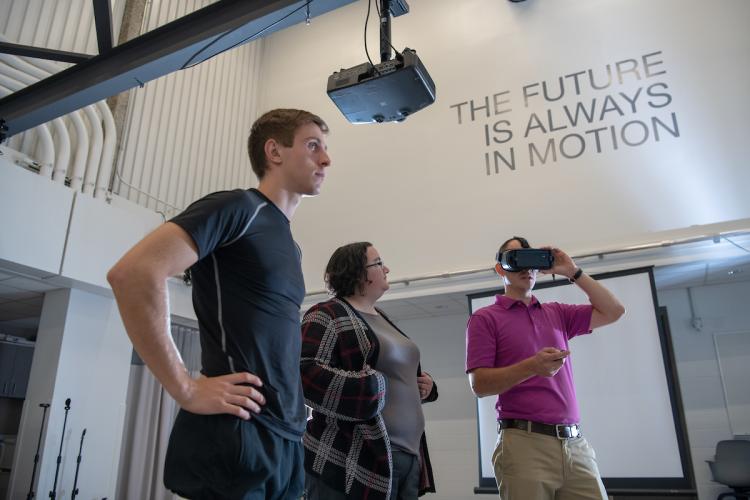
NIH awards more than $1 million for virtual reality and injury recovery research

Dustin Grooms, Ph.D., was recently awarded more than $1 million in funding by the National Institutes of Health (NIH) for his work with virtual reality and injury recovery.
The project, known as Augmented Neuromuscular Training, uses 3-D motion capture technology to better understand non-contact injuries and how athletes can be trained to avoid them.
“What’s weird about a lot of injuries is they happen without contact,” Grooms, associate professor of physical therapy in the College of Health Sciences and Professions (CHSP), said. “Something happens where your body allows your joint to go into a position that causes a ligament rupture.”
Grooms said the strangest thing about these injuries is they’re often caused by a common movement. These injuries are related to the neural control of coordination, and according to Grooms the current methods to train the body to prevent these injuries are typically not successful.
“What our lab tries to do is better understand how the brain and the nervous system generate a movement that contributes to coordination errors that cause these injuries,” Grooms said.
To achieve this understanding, Grooms and his team use 3-D motion capture, the same technology used to generate animations for movies and video games. Instead of animating monsters and superheroes, Grooms uses it to capture the movement of a person’s joints.
This technology combined with brain imaging allows researchers to understand how the body moves and how the brain activates to do those movements.
Athletes are modeled in the 3-D motion capture, and then able to wear a VR headset that provides live feedback on their movements. During this training, the athletes are implicitly trained to avoid high-risk movements that lead to non-contact injuries.
The NIH-funded research focused on developing a new intervention targeted at brain changes caused by non-contact injuries and how to use that knowledge to develop improved methods of injury prevention training. For one of the two grants, research is being carried out in a joint partnership between Ohio University and Dr. Greg Myer at Emory University.
For Grooms, this project comes from a career’s worth of experience working with injured athletes.
“I trained to just work in a rehab clinic and treat patients. I had no goal to do research,” Grooms said. “But in treating patients I found that the therapies we offered just weren’t effective enough.”
Grooms said in physical therapy that he would spend hours a day with patients and develop a relationship and hope for them to do well, but due to ineffective rehabilitation methods, it often wasn’t enough.
“Your patients return to their sport or daily life and they may still have pain or get hurt again, and you kind of feel like you let them down,” he said. “So, I went back to do a Ph.D. and see how we could make therapy better.”
Returning for his Ph.D. led him down his current path. Now, he is taking an active role in improving the options for physical therapists and working to replace the methods he was disappointed by.
While medical practice is often years behind the science, Grooms said he is starting to see the use of this technology embraced much more widely. However, he still anticipates that it will take time.
The team includes doctoral students Meredith Chaput, Amber Schnittjer and HoWon Kim, as well as faculty collaborators Brian Clark, Ph.D., professor of physiology and the Osteopathic Heritage Foundation Harold E. Clybourne, D.O., Endowed Research Chair; Associate Professor Janet Simon, Ph.D.; and research associate Byrnadeen Farraye, with contributions from undergraduate and master’s students. The team hopes to eventually make the technology more accessible and affordable for all those who can benefit from it, from high schoolers to the world’s top athletes.
“Dr. Grooms is at the forefront of research that is redefining concepts currently surrounding effective post-injury rehabilitation, and we're proud to have him and his team at OHIO,” said Interim CHSP Dean Dr. John McCarthy. “The impact of cognitive processing and memory, and how to effectively intervene biomechanically and cognitively, is a revolutionary trend that is changing the way we think about health and rehabilitation.”
In addition to his work that garnered NIH funding, Grooms has also been working on a project funded by the U.S. Department of Defense (DOD).
In 2017, the DOD granted $750,000 for research focused on the brain’s role in the recovery process of injuries rather than injury prevention.
The DOD took special interest in Grooms and OHIO’s work in this field because it shows potential to both improve tactical performance and help members of the armed forces return to duties quicker following an injury.
Much like the NIH-funded research on the brain’s connection with preventing injury-inducing movements, the DOD-funded project uses the same 3-D motion capture technology to better understand the brain’s connection with movement mechanics.
In particular researchers are looking at the relationship with movement mechanics following ACL reconstruction surgery and how the brain adapts to rehabilitation methods during the rehabilitation process.
Thanks to the progress made through this research, the DOD granted another $248,025 in funding to continue the work of Grooms and his team.
Research was supported by the National Institutes of Health under award numbers 7R01AR076153 and 1R01AR044248. The content is solely the responsibility of the authors and does not necessarily represent the official views of the National Institutes of Health.